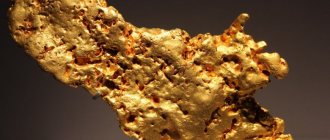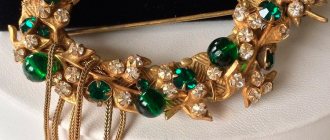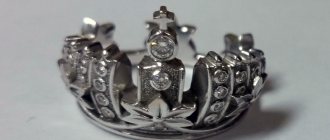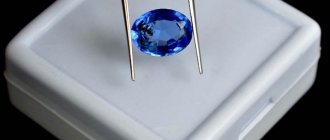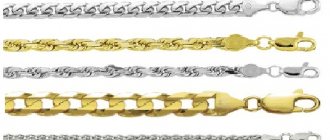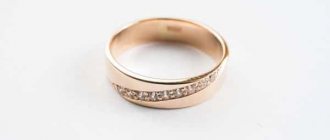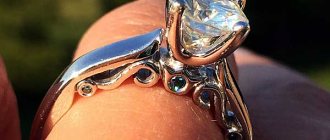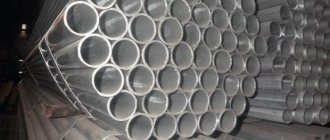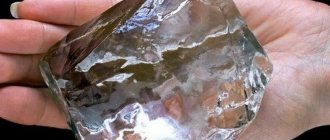“If a jeweler is burned after death, what will be left of him is a 5-gram gold bar,” jokes 24-year-old Alexander Tokmakov, one of the youngest jewelers in Tula.
Sasha told Myslo correspondents how people come into this profession, why it is dangerous, how a jewelry workshop is organized, what unusual things customers ask for, and how jewelry is created.
How to become a jeweler
—What did you dream of becoming as a child?
- Firefighters. I thought that this was a courageous profession and that everyone respected firefighters. But then I found out that they were getting pennies, and I changed my mind. I was involved in sports - powerlifting, so after school I decided to enroll in the Faculty of Physical Education. But he didn’t become a physical education teacher either: a jeweler he knew suggested going to him as an apprentice, his father supported him and said: “Go, you’ll always earn money for food.”
I was hooked on this profession as soon as I saw the metal melting - it was very beautiful!
For a whole year, every day after classes at the university, I went to the workshop, studied, and then began to carry out simple orders. A year later, my teacher went on vacation, leaving all the work to me. I was very worried: it was scary to work without support, I was afraid of messing up. But I did it, and also earned money.
— Do you remember your first completely independent job?
- Yes, I still keep it. This is a pair of silver wedding rings. They are terrible (laughs): there are visible seams on the rings, they are uneven, and not polished properly.
— As for “earning money for food”: does a jeweler always have work?
- Yes. Firstly, in store-bought jewelry, something often tears, bends, breaks, and people go to jewelers for repairs. Secondly, in the workshop you have the opportunity to make jewelry that no one else will have. According to any sketch, any shape and size.
Pendants in the shape of boxing gloves were made as a gift for world boxing champion Alexander Besputin, who trained in Tula last summer.
Again, handmade: even two identical rings will never be the same. I once had an order from Israel: a girl asked for ordinary congo earrings (rings). There are plenty of them in stores, but she wanted handmade ones.
Weave bracelet "Pharaoh" and lock "Box". The jeweler says that this was his most difficult job in a year.
— What talents and qualities are needed to work as a jeweler?
– You need to have perseverance, hard work and communication skills. The ability to communicate is very important - you work not only with metals and stones, but primarily with people. As for talent, today you don’t have to be an artist to work in the jewelry industry: in our age, most products are made using a 3D computer model.
Technology for creating precious jewelry
They can be done in several ways, each of which has its own characteristics. The main methods include:
- Casting. Technology for the embodiment of author's ideas - allows you to create original earrings, pendants or rings. It involves making a plaster mold and then filling it with molten metal. After complete cooling, the gypsum is broken and the workpiece is removed. The piece then undergoes final processing, including the process of adding stones.
- Stamping. Used for the manufacture of standard forms. Suitable for creating brooches and pendants. The basis for them is sheet gold or silver. The figured image is obtained using a print. Finally, the surface is polished and decorated with other materials.
- Rolling and weaving. The essence of the technology is rolling precious metal into wire and winding it onto reels. Bracelets and chains are woven from the resulting material - manually or using a chain knitting machine.
Weaving chains
Modern processing methods allow you to create jewelry of any size and shape.
The most unusual and most expensive orders
— Are there orders that surprise you?
- Yes. For example, there was a 370 g silver anchor chain that a 100 kg bodybuilder was going to use to do pull-ups. Colleagues said that nothing would work, it would break - but it didn’t break.
The accordion pendant was ordered by a client from another city. “Thanks to this order, I remembered how an accordion differs from a button accordion,” says Alexander.
Once they ordered me a medallion with a pentagram, which I had to finish making on Tuesday - only on this day there is some special energy.
Sometimes they order things that many people wouldn’t even think of, but I’m not surprised: everyone has their own cockroaches, everyone lives as they want. That’s why I do it, and if a person is happy, I’m happy too. One of the most unusual orders was a silver rod for the urethra. The customer wrote that he was satisfied.
— What is the most expensive jewelry that was ordered for you or brought in for repair?
– We ordered two large chains made of 750 gold for 550 thousand rubles. And for example, they brought in a Cartier bracelet worth 1.2 million for repair; a diamond fell out of the jewelry. It’s exciting to work with such things; it’s scary to damage or ruin them. It's better not to know how much it costs at all.
Materials and tools for work
In order for products to sell quickly, you need to make their appearance unique and use only exemplary raw materials. Before opening a workshop, you need to purchase high-quality equipment, precious stones and metal ingots, which will be needed in the process of creating new masterpieces.
Where to find material
There are several ways to purchase gold or silver:
- order from one of the banks;
- cooperate with mining companies;
- buy old jewelry.
In the first case, the bank will take a commission. And if you purchase scrap valuable metals for melting, there is not always a guarantee that the raw materials will be of good quality. Therefore, it is better to choose the second method.
Non-ferrous metal scrap
Semi-precious stones can be bought at exhibitions and fairs if they are needed in small quantities. It is better to order materials in large quantities directly from the manufacturer. And it is better to purchase expensive precious stones only for a specific order, when there is a guarantee that the product will be sold. And they must certainly have a certificate confirming their authenticity.
Equipment for the production of
You don't have to buy all your jewelry making supplies right away. At the initial stage, a certain minimum will be sufficient. You will need:
- blowtorch;
- hand rollers;
- vices of different sizes;
- engraving machine;
- Sander;
- scales with increased accuracy;
- mold - a form for molten ore.
When opening a workshop, you can’t do without a set of tools. This list includes:
- mini pliers;
- wire cutters;
- anvil;
- double-sided files;
- tweezers of different sizes;
- set of hammers;
- binocular glasses.
To save money, some equipment and tools can be purchased second-hand. Only during the purchasing process you need to check whether they are in working order.
What ails jewelers
— Do jewelers have occupational diseases? Is the work harmful?
– Not that it’s harmful... But it has its “sores”. Astigmatism develops from working with small details and constant eye strain. Your hands suffer, sometimes they become calloused and bloody, and it’s inconvenient to work with gloves.
When sandpaper is used, gold and silver dust hangs in the air, which you breathe, and it never leaves your lungs.
If a jeweler is burned after death, I am sure that 5 grams of pure gold will remain (laughs). You can slightly reduce this harmful nuance: install a Chizhevsky chandelier, have more flowers in the workshop, or keep the window open.
Forming a ring model
When the designer has decided on the appearance of the ring, and the technologist has given the go-ahead to cast the jewelry in metal, the next stage is creating a prototype of the future product.
For this, rubber molds are used that are filled with wax (“waxes”), or a modern, but more expensive, 3D printing method. It allows craftsmen to see what the ring will look like after production and, if necessary, adjust its parameters.
After final approval of the model, the master recreates an exact copy of the ring, which will serve as a cast for casting.
How jewelry is created
— How long does it take to make one decoration?
- It depends on what to do. A pair of wedding rings can be made in half an hour. 100 g chain - about five hours. And there are some orders that you sit on for a week. I spent five days, seven hours each, working on the “Byzantium” or “Fox Tail” weaving chain: it is assembled from many rings, a very difficult job.
This is what the Fox Tail weave looks like.
— What tools does a jeweler use?
- There are simply a trillion of them. Many of them are familiar to everyone - a jigsaw, a gas torch, wire cutters. Some tools came from dentistry, and special ones include a furnace, a polishing machine (I made it myself), and an ultrasonic bath for washing products.
Some of the tools a jeweler uses.
— What is the process of making jewelry?
– It all starts with a sketch, and then we either create a 3D model and use it to make a product in a special oven, or we make the decoration by hand. I prefer to work with my hands. For example, this is how the process of making a ring works.
First, the metal is melted in a crucible.
The metal is poured into the mold, we begin to form a square out of it.
The metal must be constantly heated red-hot to remain ductile. The finished square is rolled in rollers and joined into a ring with solder. In order for this semi-finished product to turn into an even circle, it is tapped with a wooden or textolite mallet, which does not leave marks on the metal.
The ring size is checked with a ring gauge or caliper.
Sanding removes all imperfections and creates a scratch-free surface.
Then we polish the surface on a polishing machine. When polishing, pastes of various fractions are used, they make the surface mirror-like.
The final stage is to wash the product in an ultrasonic bath. The entire process of making the ring took 25 minutes.
— Was it ever that you wanted to keep a piece of jewelry made for another person?
- Was. Large ax pendant on a thick chain. For the first time in my life I felt sorry for giving an order.
The same axe.
— Do you have to redo a thing if something is wrong?
– It happens that when I myself don’t like the result, I redo it until I’m satisfied. And the customer sees the product several times in the process, at “semi-finished” stages, and can make his own adjustments.
— Does it happen that you dissuade a customer from some absurdities?
– No, I never impose my opinion, I can only suggest, but not dissuade. Whatever a person wants, the main thing is that the decoration brings him joy.
facts about jewelry
Jewelry production
Category: Various non-food products
Features of jewelry production.
First, a sketch is developed and a model of the jewelry is created. The main processes for making jewelry: procurement of materials, creation of a form, finishing, artistic processing, cutting and setting of inserts (stones).
Cutting is done on special machines. Common types of cuts: diamond, rose, table, step, cabochon.
Securing the stones
in
products.
The place where the stone is attached to the products is called the caste (frame); the caste must firmly hold the stone. There are different ways to secure stones in products. Settings: pronged, smooth, grisant, sprinkled, etc.
Prong setting is the most common. The stone is secured with the help of paws (prongs), which bend and cover the stone from all sides.
Grisant setting - the stone is secured around the circumference with a metal rim and finished with a fine notch - grisant.
With smooth setting, the stone is secured in a caste or in a drilled socket, the edges of which are crimped against the edges of the stone.
The technological cycle at a jewelry enterprise begins with the purchase of raw materials - precious metals, jewelry inserts and auxiliary materials. Bullion is purchased through a bank. Moreover, in addition to the purchase and sale agreement, the acquisition of bullion is formalized by an act of acceptance and transfer of valuables. Incoming quality control when accepting ingots is usually not carried out, since the bank guarantees that the ingot corresponds to the standard indicated on it. The bars are also accompanied by a certificate or passport. Jewelry inserts are purchased from manufacturing companies or cutters. Each diamond must be accompanied by a quality certificate. Incoming inspection of faceted inserts is carried out by external inspection. Precious metals and inserts, decorated in the prescribed manner, enter the production workshops. Technological operations in the production of jewelry are divided into basic and finishing. The main ones include melting, casting, stamping, rolling, annealing, drawing, chain knitting, degreasing, soldering, washing and drying. Finishing operations include finishing operations, which can be different for each type of jewelry. For example, for chains there may be chipping, softening, pressing, diamond processing, diamond cutting, cutting, final assembly (or ending). For rings - grinding, polishing, matting, applying a protective and decorative coating, setting the insert, etc. Melting is a technological process in which metal ingots are transferred from a solid state to a melt when exposed to appropriate temperatures, and by adding the required amount of alloys, a alloys of a strictly established standard. In other words, the essence of the process is to obtain an ingot of the established standard required for production from a high-grade ingot. In modern production, continuous casting induction furnaces are most often used for melting. Gold bars are loaded into the furnace, alloying additives are added in the required quantity (in accordance with the grade of the alloy), and heating occurs using magnetic induction induced by medium and low frequency currents in a crucible of pure graphite. In the melting chamber, all components are mixed by an induced magnetic field. Ultimately, a finished alloy of the required sample is obtained, which comes out of the melting furnace in the form of a rod or plate. Next, operational quality control of the resulting alloy is carried out by conducting a quantitative chemical analysis to determine compliance with the standardized content of precious metal. Usually they try to get a positive remedium of +1 or +2. From the chemical laboratory, a gold bar or plate of the appropriate standard (for example, 586 or 751) is sent either for rolling (to subsequently produce chain, stamped or filigree products) or for jewelry casting using lost wax models. Casting is a technological process of forming a product from a liquid melt in a mold. The main type of jewelry casting is lost wax casting. With this method it is possible to obtain a surface finish of class 4. High surface cleanliness is achieved as a result of forced filling of the casting cavity of the mold with liquid metal under the action of vacuum suction or centrifugal forces. The jewelry casting process can be thought of as consisting of the following operations: 1. Making a master model from gold, silver, brass, copper or other hard metal with a melting point above 300 °C by hand. The master model must be 10% larger than the finished piece of jewelry to be received. This is necessary in order to take into account the shrinkage of the rubber mold (2-3%), the shrinkage of gold (1.25-1.5%) and the waste generated during filing and polishing of the product. 2. Manufacturing of rubber molds. To obtain a rubber mold you need: a master model, molding raw rubber, a vulcanizing press, a metal flask. 3. Making a wax model. Melted jewelry wax is injected into a rubber mold using a syringe. 4. Making a wax Christmas tree. Wax models are soldered to a wax riser (sprue) with a diameter of 5-7 mm using an electric soldering iron at an angle of 45°. 5. Manufacturing of foundry molds. The wax Christmas tree is placed in a metal flask and filled with fireproof gypsum mixture. The mixture hardens, leaving the sprue on the outside. 6. The melting of wax from the flask occurs when the casting mold is heated, leaving its inner cavity in the shape of a “herringbone” empty. 7. Metal is poured into the flask by force either by centrifugal casting (rotation of the mold) or by vacuum suction. 8. Cleaning of castings. Performed manually using a brush and warm water or in an ultrasonic bath. 9. Disassembly of the finished casting. This is done using wire cutters. Rolling (rolling) is an operation that involves repeatedly pulling metal (rod or plate) through rotating rolls. This produces sheets or profiled products of various thicknesses. A rolling mill is used for rolling. The rolling mill produces a plate thickness of about 1 mm and round and square wire with a diameter of about 1.5 mm. Reducing the diameter of the rod changes the internal structure of the alloy, making it more brittle. Therefore, after rolling, it is necessary to restore the metal structure and relieve internal stresses. For this purpose, annealing is used, which must be carried out after each change in the diameter of the semi-finished product. Annealing is the process of heating a metal alloy to a given temperature, holding it at this temperature and then cooling it. It is carried out to eliminate the heterogeneity of the crystal structure, relieve internal stresses formed in the metal during its processing - stamping, rolling (rolling). The purpose of annealing is to bring the alloy into an equilibrium state. The heating temperature of gold ranges from 700-750 °C, silver - 600-650 °C. Cooling is carried out in a switched-off muffle furnace until it cools completely or outside the furnace at room temperature. The holding time during annealing of alloys ranges from 5 to 20 minutes. Annealing in muffle furnaces leads to oxidation of the alloy, i.e., to partial loss of the alloy alloy and the formation of an oxide film, the removal of which requires the use of another technological operation - bleaching. To partially protect the alloy surface from oxidation, a protective gas (dissolved ammonia) is supplied to the muffle furnace. After annealing, the plates are sent to the stamping operation, and the rod is sent to the drawing operation. Stamping (stamping) is the process of processing materials by pressure as a result of plastic deformation of the workpiece in dies. When stamping jewelry, a design is pressed out, which is engraved on the stamp form. Products of complex shapes are stamped in several stages with intermediate annealing. Mass-produced products are made using the stamping method. An example would be the making of wedding rings. Stamping and die-cutting are widely used, for example, in the manufacture of cutlery (forks, spoons, knife handles). Drawing is a process that results in the production of round wire with a certain (specified) diameter (up to 0.1 mm). The wire is pulled through the holes of the dies with uniform tension, sequentially from a hole with a larger diameter to a hole with a smaller diameter, without missing a single one; otherwise, the quality of the wire is significantly reduced, since the material is subject to excessive stress. The dies are constantly lubricated with an emulsion based on vaseline oils to prevent overheating of the wire. As a result of the drawing operation, a wire of a strictly defined (specified) diameter with an indefinite length (in a coil of up to 100 meters) is obtained, which is again sent for annealing. Wire is used in the production of chains, woven bracelets, filigree products, as well as finishing products obtained by casting. To produce chains and woven bracelets, the wire is sent to the chain knitting shop on chain knitting machines, which make it possible to produce products of various weaves (anchor, armor, cord, etc.). Chain knitting machines allow you to produce about 400-500 links per minute. The result is a chain of indefinite length with unsoldered links. After automatic chain knitting, the products are washed and degreased and sent for soldering. Using a solder applicator equipped with two drums, the coil of chains is treated with a powder mixture consisting of metals, flux and sprayed antioxidants. The powder mixture contains the following substances: zinc, boric acid, sodium pyborate, phosphorus, phosphorous blister copper, red copper and, in some cases, silver and cadmium powder. As a result, the powder is distributed throughout the chain and falls into the gap between the links, remaining there. Excess powder remaining on the surface of the links is removed using a similar installation. Next, the chain is placed in a soldering oven. When the chain enters the heating chamber of the soldering furnace, the melting additive included in the mixture lights up, increasing the temperature at the junction of the link by 30-50 ° C and soldering the link itself. Due to the minimum gap distance (several microns) in a chain link, when soldering, the links are soldered together without the help of solder. The result is chains with soldered links that do not require additional grinding, since no oxide forms at the site where the link is soldered. Manual soldering of chains using solder and a soldering iron is practically not used in modern enterprises. However, the soldering process is used to attach individual parts of the product (for example, overlays, welts, etc.). Soldering is the process of producing permanent connections using low-melting metal alloys (solders). A permanent connection is obtained by wetting molten solder, heated to a plastic state, with the edges of the base metal and subsequent cooling of the junction. In jewelry making, flame soldering is mainly used. The gas burner must provide a heating temperature within 1,100 °C. A higher melting temperature (up to 1,300 °C) is provided by a gasoline soldering apparatus. Solders used in jewelry soldering are labeled according to the percentage of precious metal they contain. Requirements for jewelry solders: 1) compliance with the product sample; 2) matching the color of the product; 3) the melting temperature of the solder must be at least 50 °C lower than the melting temperature of the metals being fused. Gold solders of 750 standard: 1. PZl75Sr15M7.35Ts - solder color is yellow, operating temperature 840-860 °C. 2. PZl75Sr7.5M5.5Pd5N2Ts - solder color is white, operating temperature 900-1000 °C. Gold solders of 585 standard: 1. PZl58.5Sr 15M22Kd2Ts - solder color is white, operating temperature 800 °C. 2. PZl58.5Sr16M20.5Kd2Ts - solder color is reddish, operating temperature 780-800 °C. 3. PZl58.5Sr26M7.4Pd6Ts - solder color is white, operating temperature 860-880 °C. Silver solders of 700 standard: PSr70M22.4Ts - operating temperature 720-750 °C. To clean the fused surfaces from metal oxides during soldering, fluxes are used, which are solutions of borax and boric acid. The most universal flux for soldering gold items is an aqueous solution of borax and boric acid in a 1:1 ratio. Bleaching. After annealing and soldering, the surface of the products must be cleaned of the oxide film (the result of annealing) and flux particles formed during soldering. The process of removing oxide film and flux is called bleaching in jewelry. It is carried out in porcelain or glass baths, since the bleaching solution contains 10-15% sulfuric or hydrochloric acid, 5% copper sulfate (the rest is water). Bleaching temperature is 60-80 °C, time is from one to five minutes. You need to know that you can only immerse and remove the product from the bleach solution using acid-resistant tweezers or a spoon made of copper. Filigree is obtained by twisting two or more wires to form a rope, which is flattened into a ribbon with oblique scars formed along its edge. There are various scanning techniques. When applying filigree, the pattern is typed onto the body of the product and then soldered, the space between the wires is enameled with colored enamels. The result is a floral ornament or other design. With openwork filigree, the base is hard paper or cardboard, onto which the design is applied. According to the design, scanned wire is laid out in the form of curls, spirals or ornaments, which is glued to the cardboard with nitro varnish or wood glue. Individual parts of the scanned wire are sprinkled with powdered solder and soldered. When soldering, paper and cardboard burn out, leaving an openwork metal pattern. Openwork filigree is used in the manufacture of fruit vases, candy bowls, glass holders, brooches, rings and bracelets. Overlay filigree is used for finishing metal products (shot glasses, glasses, goblets, miniatures). Grain elements are often used in filigree products. Grains are small, smooth balls of gold or silver that are an element of a filigree piece. In addition, the grain in some cases borders the jewelry, in others it is located on a plane in the form of geometric shapes (triangles, rhombuses, etc.). Grain is an indispensable element of floral ornament; it is the gold and silver balls that form the relief clusters, fruits and inflorescences. The grain balls are placed on the base using glue and then soldered. After the main operations, all products are washed in ultrasonic baths and dried in drying drums with hot sawdust. Next they move on to finishing operations. As mentioned above, the types and nature of finishing operations can vary greatly for different types of jewelry, but almost all products undergo grinding and polishing. Sanding is used to create a smooth surface using rotating leather, felt or cotton sanding wheels using sanding powders on sanding machines, as well as by hand. The surface of the product after grinding acquires a matte color. Polishing gives gold and silver products a mirror-like shine with a high reflectivity. The polishing process is carried out on a polishing machine using polishing pastes and leather, felt or cotton polishing wheels, as well as manually. Engraving is the application of shallow cuts to the surface of metal products using cutters (stiches). Engraving reproduces paintings or ornamental designs. The process of engraving (as well as during embossing) consists in applying a design to a metal product with a steel needle, which is deepened with the help of gravers. The graver consists of a wooden handle and a steel cutter. The engraving process involves removing metal shavings along the contour of the design. Notching is a method of obtaining a pattern by inlaying metal. With the help of a gravel, recesses are made in the metal into which plates or wires of another metal are screwed (inserted) to obtain an ornament or pattern. Embossing is the application of drawings, inscriptions, or patterns to the surface of a product by hand. The operation consists of fixing a sheet blank on the surface of a wooden box, previously hot-filled with resin. The contours of the design are applied to the sheet blank with a steel needle, and then, hitting the embossing with a hammer (blunt chisel), elevations or depressions are made on the sheet blank. The coins are made from a softer metal than the metal of the sheet blank to prevent scratches on the metal of the blank. Gilding and silvering are coatings of less resistant metals that are more resistant to corrosion and mechanical wear. Gilding and silvering give the products an elegant and noble look. Coatings are applied: - by dipping into molten metal; - rubbing (most often silver); - electrolytic method. The electrolytic method is the most technologically advanced, as it allows the application of a thin, even coating. The process involves depositing a layer of metal from an aqueous solution of its salt onto the surface of a product under the influence of a direct electric current. The thickness and quality of the coating layer are regulated by the residence time of the product in the galvanic bath, the concentration of the solution and the current density. For earrings, brooches, medallions made of silver, the thickness of the gilding layer is 1 micron, for chains - 2 microns. Cutlery (forks, spoons, knife handles) made of cupronickel and nickel silver have a layer of silver of 24 microns. Oxidation is the process of applying a protective oxide film to the surface of a product. Copper and copper alloys and aluminum are subjected to oxidation. It is produced by immersing products in a hot solution of “sulfur liver” (1 part sulfur and 2 parts potash). The length of stay in the solution determines the color of the protective film (from light to dark). Blackening. In everyday life, the oxidation (darkening) of silver in natural conditions or the coating of silver with black film in hydrogen sulfide water is understood. Black enamel is also taken for blackening when enameling silver, but this is a different technological way. Actually, the process of blackening is the imposition of a mixture on silver products prepared from silver, copper, lead, drill and sulfur (the main element) with subsequent firing. The surface of the product to be injected must be polished. The pattern is applied to the surface, the engraving depth is 0.2-0.5 mm, then the surface is degreased and the prepared mixture is applied. After that, the product is dried and burned at a temperature of 300-400 ° C. As a result of firing, the mixture is melted, filling all the strokes of the picture. After cooling, the product is polished and polished. Enameling - decorative coating of the surface of metal products with enamel. The assortment of enamels includes: 1. Cold enamels - based on urea -formaldehyde resins, which are applied to the product with a spray or brush, and then dried. 2. Hot glassy glaze are applied to the product in the form of paste, and then burned. Depending on the light permeability, they can be: - transparent (a metal base is visible through the enamel); - translucent or pale (overflowing in the light); - Deaf or colored (close the metal base). According to the application method, they distinguish: - a blocked enamel, filling the gaps between the walls. From the partitions, a drawing (pattern) is typed on the product, then the partitions are soldered to the surface (surface of the metal). Partitions can be strip (rectangular to the profile of the tape), soldered to the surface, and the scanning wire, also soldered to the surface; - Walking enamel, filling the recesses of the pattern carved in metal. In this case, the untouched part of the surface of the metal becomes an element of the ornament (drawing); - Emall on the thread. As a rule, transparent enamel is applied to the surface of a engraved product in the form of an ornament, rays, etc. As a result, the product acquires volumetric faces; - Emall in relief. Transparent or deaf enamel is applied to a cast or minted relief or pattern; - Watering enamel, used mainly in the manufacture of enameled dishes. In jewelry, irrigation enamel with overlays is widely used, that is, before the last firing on the enamel, stamped or in another way performed images from a gold or silver sheet are placed; A pattern, ornament can be laid out. Next, the product is burned, while the pattern is soldered into an enamel layer; - Rodestic enamel. This is painting with enamel colors, in which several firing occurs. After each firing, the artist complements the drawing with new colors and details, and after each mural, the product should be firing at a temperature of 800-900 ° C. After the completion of the main and finishing operations, the quality of finished products is controlled. Continuous quality control - for products made of precious metals and alloys, selective - for suburgical. The name is applied to high -quality products and directed for propagation and branding to the territorial inspectorate of vast supervision.
Types of setting inserts in jewelry
Jewelry with inserts have one common detail, which is called cast. A cast is a metal part of a piece of jewelry that is used to secure the insert. It must meet the following requirements: - hold the insert firmly; — emphasize the natural beauty of the mineral; - serve as a connecting transition between the metal part of the decoration and the insert; - fit harmoniously into the product without violating its aesthetic and artistic integrity. Castes can be of various shapes: single, double, lattice, openwork, flat. In jewelry practice, the following main types of setting of inserts are used: 1. Blind setting (or crimping). The cast has the shape of a flattened ribbon rim with a flat bottom. The insert is held in the frame by uniformly pressing the upper edge of the stand against the girdle of the stone along the entire perimeter (Fig.). The piled-up layer of metal is cut at a certain angle and polished. This creates a smooth metal surface (ridge) around the insert. This surface can be decorated with a notch (grisant), creating a grainy frame around the stone. The size of the grisant notch is determined by the size, shape and type of insert. In some cases, to better illuminate the stone, a through pattern can be cut out in the ribbon rim. 2. Prong setting. The most common type of setting for transparent jewelry stones. In this case, the stone is held in the frame not by the entire surface of the welt, but by individual strips of metal protruding in the form of spider legs, which are called prongs. The prongs press the insert along the girdle, as if lifting it above the surface of the product (Fig.). In such settings, the stone looks much more elegant, maximum shine and play of light are ensured, but with this setting, increased demands are placed on the fastening (soldering) of the prongs, the number of which ranges from four to eight. 3. Corner setting. This type of setting is used when the stone is fixed not in the caste, but directly in the metal. It is mainly intended for small stones or for several stones located in the product at a very close distance. Special holes (seats) are drilled into the product, which should ensure a tight fit of the stone. Having installed the stones in the mounting sockets, use a gravel to lift the metal in the form of a stroke and push it towards the insert so that it falls on the stone. Next, the metal stroke is shaped into a ball. This ball, called a corner, performs the same role as the prong that holds the stone. 4. Rail fastening. It is used in cases where it is necessary to secure several faceted stones sequentially (in one row). In this case, a blind caste is used, shaped like a channel. The stones, inserted into U-shaped recesses between two guides, seem to line up one after another, touching the sides and forming a bright sparkling line. Thus, each faceted insert is held on two sides by metal guides, and on the other two by adjacent, sequentially located stones. Rail setting is one of the new types of fastening of jewelry stones and is currently very popular. 5. Fastening with pins. Suitable for stones used as pendants in earrings, pendants or brooches. The insert is secured with a pin, tightly screwed into a hole pre-drilled in the stone. The pin ends with a hook or ring, through which the pendant is connected to other parts of the product. 6. Adhesive fastening. It is used for fastening inexpensive inserts made of glass and decorative plastics, as well as for opaque ornamental stones, most often processed in the form of cabochons, and pearls. Glue is applied to the product, the insert is applied and pressed. Pearls are secured in recesses that have a pin, after drilling a hole in the pearl 2/3 of its depth and with a diameter corresponding to the size of the pin. Glue is applied to the pin and into the insert hole, after which the parts of the product are connected.
How much gold is in the ring?
- Fineness on jewelry indicates the percentage of pure gold and silver it contains. In a 585 carat ring, gold will be 58.5% of its weight, the rest will be copper and silver (their ratio will vary depending on the shade of gold: red has more copper, lemon has more silver) or copper and palladium in white gold. 925 sterling silver jewelry will be 92.5% pure silver, the rest will be copper. Pure precious metal is too soft, it bends in your hands, and jewelry cannot be made from it.
- Gold jewelry can be full or hollow. The full chain is made of wire, the hollow chain is made of tubes. The second weighs less and at the same time looks more voluminous. But the first one is more reliable: the wire links are stiffer, they are more difficult to break, and they do not fray much longer.
- There is an opinion that jewelers cheat with the weight of the metal, secretly squeezing precious grams from the customer. In fact, 9% of the precious metal is lost during the manufacture of a product: it burns out during melting, turns into dust during grinding, which cannot be collected and given to the customer, and is removed during polishing. These are all production losses, and not the jewelers - the swindlers.
- Many of our grandmothers and mothers had jewelry with rubies. In fact, this is not a ruby, but corundum - an artificially grown stone that has no special value. Real rubies are very expensive.
- On some people, silver jewelry turns black. This is not due to the low quality of silver, but due to the chemical composition of the body's sweat and fat secretions: silver reacts to sulfur and chlorine. You can clean the darkened jewelry, and think about your health.
Casting
The molten precious metal is cast into a specially made mold. When it freezes, it takes on the appearance of a future decoration. A distinctive feature of cast parts is their volume.
The mold is made from molding plaster or other special cold mixtures, which are poured into a container with a Christmas tree - three-dimensional models of decorations on branchy jewelry wax. After hardening, cavities remain in the plaster into which metal is poured.
How to make a copper ring with your own hands
A copper ring is the name given to jewelry made from either a solid strip of copper or wire.
How to make a ring with your own hands:
- Cut a ribbon from thick copper or 2-3 from a thin sheet.
- Apply flux to the surface to prevent the copper from oxidizing.
- Lay out the solder - a special material for soldering, and heat it up.
- Immerse the strips in acid, which is sold in specialized stores. As a result, they will stick together tightly.
- Using sandpaper, smooth the edges of the resulting copper plate.
- Bend it into a closed ring with pliers.
- Place it on the mandrel and hammer it to give the correct shape.
- Sand the edges and surface with sandpaper.
- To get the usual dome-shaped shape, it is recommended to sand it with a special machine.
- At the very end, polish with cotton wool.
It is much easier to create a decoration from twisted wire . To do this, you need to wind a piece about 0.5 meters long onto a crossbar or its substitute, leaving long ends, then start twisting them into a spiral, holding it with your finger so that it is even. When the spiral reaches the desired size, remove the ring, press the coils with pliers, cut off the ends, fold the remaining pieces and press them to the wrong side. It turns out to be a beautiful ring with a spiral decoration.
How to make a signet ring
Making a unique designer signet ring is possible using an ordinary nut. For work you will need a grinder, a file, sandpaper (grit - from 220 to 600), a file, a knife, a vice.
Manufacturing algorithm:
- Secure the nut with a vice and round all sides except one - leave untouched for printing.
- Grind down the sides and the inside threads using a drill.
- Smooth the surface with a file, polish with sandpaper until the resulting product becomes matte.
The pattern on the signet is made by engraving.
DIY ring with stone
Jewelry with stones is made on a special round base, which can be purchased at a craft store.
Required materials for production:
- natural or artificial stone;
- the basis;
- strong glue;
- handmade paint, brushes, foil;
- wire - if desired.
To make a ring with an alexandrite, emerald, diamond or any other precious or semi-precious stone, you need to draw an imitation of the frame at the bottom of the stone, glue it to the base, leave it and dry for a period of 7 to 10 hours. If the stone is artificial, after gluing it and the base can be braided with wire and painted.
